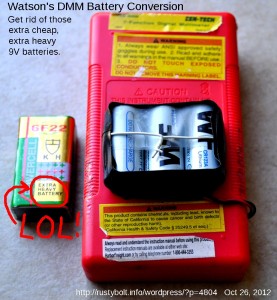 The hundred plus dollar DMM (digital multimeter) I use on the bench has an auto shutoff when it’s not being used, but the cheapo Cen-Tech DMMs from Harbor Freight do not, so if we forget to turn it off (and even the best of us do), then the “Extra Heavy” 9V battery that comes with it (see picture) soon runs down and the meter’s low battery warning indicator comes on.
The hundred plus dollar DMM (digital multimeter) I use on the bench has an auto shutoff when it’s not being used, but the cheapo Cen-Tech DMMs from Harbor Freight do not, so if we forget to turn it off (and even the best of us do), then the “Extra Heavy” 9V battery that comes with it (see picture) soon runs down and the meter’s low battery warning indicator comes on.
I ruminated about making a 3V to 9V converter a few weeks ago to solve this problem. But I have a couple packs of CR123 cells lying around without a flashlight to use them in (I gave them all away), so I decided to go the easy route and connect three of them in series and fasten them to the back of the DMM. They have a much higher capacity than the cheap “Extra Heavy” 9V battery, or even an alkaline battery, which costs about half the cost of the meter itself, which is sometimes on sale for $4 at Harbor Freight. I will not have to buy another expensive 9V battery for my meters ever again. I’ll just use up the CR123s instead. I got these CR123s for cheap from dealextreme.com, a little over a dollar apiece with free shipping, but if you buy more you can get a discount. You may think that I’m spending over three dollars and that’s what a 9V battery costs, but these three cells should outlast the 9V by several times. In the long run, the power from these is still much cheaper.
I taped three of the CR123s together with adhesive tape, and soldered a short piece of wire between the positives and negatives. Then I drilled two small holes in the back of the DMM to run the wire through to hold them in place. I used a snap on 9V battery connector, but the red and black wires may not agree with the polarity of the battery. The smaller contact must be the positive terminal, so make sure you test it with a meter before you plug it in. IMPORTANT! If it’s backwards, the DMM might be damaged!
I filed a groove in the side of the case and cover to let the wires pass through. The black electrical tape was the last to go on – three layers of it to prevent shorts. Then I screwed the screws into the holes on the back to hold it together.
About the only disadvantage I can think of with the conversion is that the lithium cells can catch fire if shorted. That’s why I put the black electrical tape around the outside: to cover the contacts and prevent shorts. Also, it will give some protection against high voltage shock if I happen to be measuring HV with the meter. The exposed cells could be at high voltage if the leads are in contact with HV.
Back to experimenting…











